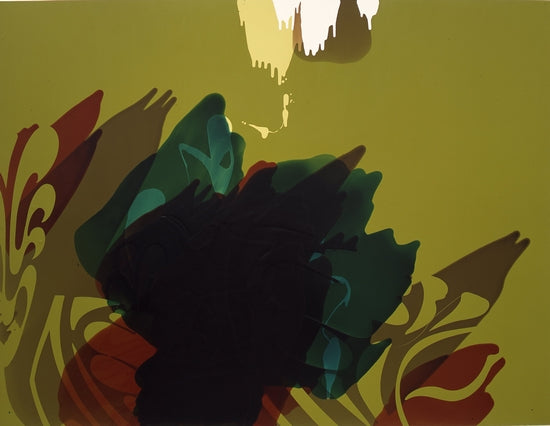A couple of week ago in my blog ‘Taste is the Common Sense of Genius’, I mentioned that I had attended the private view of artist Michael Stubbs – Solo Exhibition at the Cass Gallery in Whitechapel. The so called tagline to the show goes, ‘This exhibition contextualises Stubbs’ painting practice alongside his rarely seen paper works’. I had only ever seen his paintings so I was very curious to see where they came from and how they evolved.
Being a friend of Mike and an admirer of his work I invited myself to his studio last week hoping to gain more of an insight into where his work comes from and how it’s produced and lets face it, who doesn’t like having a nosy at how and where people work. As a maker and painter it is easy for me to see that his understanding of paint, colour and technique is absolutely expert. Using household paints and tinted varnishes with ready made graphic stencils, I wanted to see how he executed this.
Upon entering the studio the first thing you can’t help but notice is the immaculate white walls and paint caked floor, immediately I took my camera out and started to take pictures of it “I knew you would do that”, said Mike, “Everybody does”. And why wouldn’t they?

A new board being prepared against the floor of the studio. Talk about brilliant contrast.
Mike works leaning over his paintings where they are on the ground. He says he works quickly, spending only a couple of hours at a time in the studio, applying a layer of paint as a pour or in a stencil and then leaving it to dry and contemplating his next move.

Three of the six boards Mike is about to start working on being prepared. The back has the same number of coats of paint that the front does.

Ingenious use of stacked tables as shelves. A moment of monochrome on the back wall and a sneak peak of whats to come.
I know what I love about these paintings, first and foremost and as I mentioned earlier is the expertise Mike exhibits with the paint. The contrast of the thickly applied eggshell or gloss paint to the multiple layers of tinted varnish along with the free form of the pours against the strict confines of the stencils interplay with one another pleasingly. The sheer scale of the paintings, like a confined explosion is staggering. It’s the recognisable motifs, a stylised Lichtenstein brush mark, sign writers lettering, which cause me to think that it’s time to learn more about what is going on within them.
Mike explains, “Technique and making is only the means, not the end. What’s equally important (if not more so) is the context the paintings operate within. Like when a DJ plays two tracks and mixes them to make a new tune, I combine genres of Abstraction and Pop Art to make a third language in painting” So far so good, “What you get from the painting is a sensation, which arguably resists meaning and interpretation” I agree, “However, painting is always framed within the history of its particular language. When you combine this with say, the flat of the digital screen, you end up with a clash of methods and interpretation.” I have to admit I’m lost at the last line.
What does he mean if you combine the pure sensation you get from the painting with the flat of the digital screen? Is this depicted by the gloss black in many of his pictures? Or when you view paintings through a computer screen? What are the clash of methods he refers to? I can see the different methods of painting…..
All good art leaves the viewer asking questions and searching for answers, much the same way the artist is lead into a painting in the first place. information about domain . I guess it’s thrill of the chase so to speak.
I leave you with this brilliant Short Studio Film: Michael Stubbs in conversation with John Shilver from Tamazin Devereux. A wonderful look at how Mike paints in his studio and his work in his words.
And if you can, I urge you to get along to the Cass Gallery in Whitechapel this week, the final week of his show.
Details here: Michael Stubbs – Solo Show, The Cass Gallery.
Visit www.michaelstubbs.org to see and read more about Mike’s paintings on his website.
Visit Laurent Delaye to see more by the artist.










